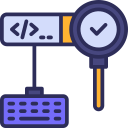Case Studies: Programming in Audit Efficiency
Explore how programming solutions have transformed audit processes, driving efficiency, accuracy, and insight within audit teams. This page details real-world case studies where technology made a measurable difference in auditing—optimizing repetitive tasks, uncovering deep data insights, and reducing compliance risks. Each section highlights a different organizational challenge addressed through innovative programming, illustrating the practical benefits and lessons learned through each scenario.

Integrating Automation to Streamline Audit Processes
Implementing Robotic Process Automation in Risk Assessments
A large financial services provider integrated robotic process automation (RPA) into their risk assessment phase, targeting the heavy manual review of transaction data. By programming bots to extract and analyze high-volume datasets, they significantly cut processing time. Previously, auditors spent hours sifting through spreadsheets for anomalies and exceptions. With RPA in place, the audit team redirected its focus to analyzing exceptions and developing deeper insights, resulting in a more thorough risk assessment process, fewer mistakes due to human fatigue, and increased job satisfaction among team members. This transformation allowed them to handle a larger audit scope with the same resources.
Automated Data Collection in Inventory Audits
For a global manufacturer, the quarterly inventory audit cycle was a laborious affair, often disrupted by delays in gathering warehouse data from multiple locations. The audit team and IT partnered to develop custom scripts that interfaced directly with the company’s inventory management software. This programming initiative automatically pulled and consolidated relevant stock data, eliminating days of manual collection. Audit scheduling became more predictable, and auditors could even execute real-time checks. Enhanced visibility led to more accurate inventory counts, highlighting process gaps that could now be addressed proactively rather than retrospectively.
Streamlining Documentation and Compliance Checks
An internal audit team at a healthcare provider faced mounting regulatory pressures requiring extensive documentation and compliance verifications. They introduced scripted workflows that automatically compiled necessary audit evidence from electronic records systems. These programming efforts ensured standardization in report generation, slashed the time spent gathering supporting documents, and minimized compliance risk by making the process repeatable and transparent. Not only did audits conclude faster, but the quality of documentation improved, passing external regulatory reviews with zero findings.
Enhancing Data Analytics to Uncover Audit Insights
In response to a rise in transaction fraud, an e-commerce company’s audit team collaborated with data scientists to create a predictive model for fraud detection. Using programming languages like Python and R, they analyzed historic fraud cases to develop features and train machine learning models. The model flagged unusual patterns in real time, alerting auditors to potential risks as transactions occurred. As a result, the company prevented several major fraud attempts early, improved internal controls, and established programming as a core competency within the audit team.


Improving Audit Reporting Accuracy and Timeliness
A conglomerate struggling with disparate systems across regions adopted programmed consolidation tools for its group audits. Tailored scripts extracted standardized data from a variety of ERP platforms and merged it into unified workpapers. This eliminated tedious copy-pasting and reconciliations, improving both the speed and correctness of consolidated reports. Audit managers noted a marked drop in post-finalization adjustments and increased confidence from executive stakeholders in the accuracy of group-wide audit findings.
